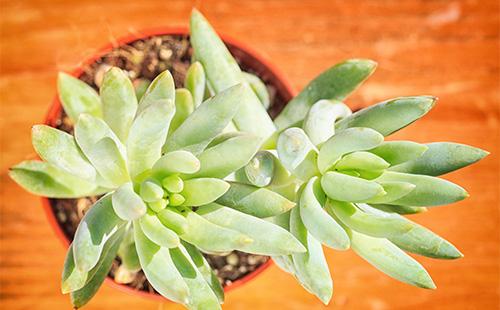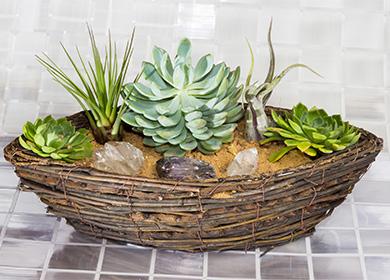The content of the article
The genus of the flower was named in honor of Atanasio Echeverria y Godoy. The Mexican artist created illustrations for books on the country's flora. Among the people, besides a stone rose, echeveria is known as a stone flower. The plant is often confused with young growth. Both are called stone rose, have an external resemblance. Despite the existence of family ties, the conditions for their maintenance are completely different. Thaw can grow in open ground during frosts. Such conditions for echeveria are unacceptable.
Description
The birthplace of the plant is Mexico. Some species are found on Texas and California lands. The flower boasts juicy, fleshy leaves that create a beautiful rosette with a diameter of 3-40 cm. Their length varies depending on the species. They can also be of different shapes and colors.
In most cases, the flowers are small, similar to bells. They are located vertically or sideways. Amaze with a color palette - from yellow to bright red shades. Color often depends on the light. Echeveria makes it easy to breed interspecific and intergeneric hybrid plants.
Types for indoor floriculture
Under natural conditions, about 150 species grow. Only a few are available for indoor cultivation. The table lists the most popular.
Table - Indoor types of echeveria
| View | Features |
|---|---|
| Graceful | - Rounded, ovoid leaves of a gray-blue shade; - flat socket; - pink or bright scarlet flowers with a yellow top |
| Agave | - Compact power outlet; - almost no stalk; - light green leaves with a red-yellow edging of oblong shape; - red or yellow rounded bell flowers |
| Brilliant | - An egg-shaped socket; - red flowers in the shape of a brush or umbrella |
| White hair | - On the surface of lanceolate, rounded leaves, small white villi; - on the tips of the leaves of the border of a brown hue; - profuse flowering brown-red |
| Derenberg | - Shaped light green leaves with a red border; - bell flowers red or yellow |
| Lau | - Oval, pointed at the end of the leaves with a waxy coating; - orange flowers with red tops |
Basic care
Despite the fact that the plant has a complex and impregnable appearance, caring for it is a force even for beginner gardeners. All you need to do is to fulfill simple maintenance requirements that are close to the natural habitat. Like other representatives of succulents, a stone rose grows slowly, but lives for a long time.
Lighting and location
The flower is very fond of bright diffused light. The ideal place is the southern, western windowsill. There should be no shadow, as the growth and formation of the outlet will be disrupted.In summer, the pot can be taken out to the balcony, loggia. The main thing is to provide protection from rainfall.
Only the acquired flower should be gradually accustomed to the sun. Otherwise, he will get burns. In winter, he may miss daylight hours. Additional lighting is provided by fitolamps.

Temperature
In summer, the temperature should be 22-27 ° C. In winter, cool air is recommended. The most optimal conditions are 6-8 ° C. In the cold season, amateur gardeners can set 18-20 ° C. But this mode leads to the extension of the plant outlet. Varieties that bloom in winter should be kept warm.
Humidity and watering
Spraying should be approached carefully. Fluffy species are found in dry climates; leaf moisture is destructive for them. As for the other plants, it is also undesirable to spray or rinse them. During the procedure, you can damage the coating of wax, which is on the foliage. Green mass loses its appearance, wrinkles.
The plant feels great, even with central heating. It is sometimes possible to wipe undescended varieties with a damp cloth to prevent the reproduction of insects.
In warm time, the soil between waterings should have time to dry by 2-2.5 cm. It is imperative that there is a pallet from which excess water is regularly drained. From May to September, watering is carried out once a week. Until mid-November, the frequency of watering is reduced to once a month. In winter, the soil is moistened only once or twice a season.
Soft, distilled salt-free water is used. Foliage wrinkled and curled up - the first and most important sign of insufficient soil moisture. It is recommended to adhere to the golden rule - the lower the temperature in the room, the less watering.
Top dressing
For feeding, ready-made mixtures intended for succulents are used. In most cases, these are products presented in liquid form. Enough half the dose, which is diluted in water. From early spring, fertilizer is applied once a month. Large amounts of nutrients damage the root system.
Priming
The substrate should be loose, nutritious. Ready-made soils for succulents from the store are perfect for a stone rose. The composition is laid brick crumb (fine) and river sand in large grains. To prevent rotting of the root system, a small amount of charcoal is added, which has a disinfecting, healing effect.
You can independently prepare a substrate from mole soil or peat, sand. Components are taken in equal proportions. Loamy soil mixes with sand.
Transfer
Young plants are advised to change the pot and soil every year, choosing an early spring. The procedure must be carried out carefully, since you can not damage the protective wax coating on the leaves. A wide and shallow container with an opening for draining excess fluid is perfect.
After purchase, the plant replants only after a few weeks. Before the procedure, the moistening of the soil is completely stopped. When placing the flower in another pot, the soil should be completely dry. Only after planting is watering carried out.
Bloom
Often, a stone rose blooms in spring or summer (May-June). It lasts two to three weeks.An amateur gardener can change the appearance of buds by adjusting daylight hours. The most optimal conditions for the formation of buds 12-13 hours of illumination for two months. Suitable for both natural and artificial lighting.

Breeding
The most common method of reproduction is vegetative. Sowing seeds is used less often, as it is more complex and laborious. For all methods, the ideal time is early spring.
Seeds
Features. The procedure falls on February-March. If after flowering boxes of fruit appeared, then you can collect the seeds yourself. If you take store material, then before sowing it is better to read the manufacturer's instructions.
Procedure
- Mix peat and sand (1: 1).
- Squeeze the seeds lightly into the soil.
- We moisten the soil from the spray gun, cover the container with polyethylene or glass.
- We withstand 20-25 ° C, regularly ventilate and spray.
- We are waiting for seedlings for two to three weeks.
- After two to three months, we plant the plants.
- We transplant to a permanent place when the outlet has grown in diameter to 3 cm.
Leafy cuttings
Features. Only healthy parts of the plant should be taken. Recommended temperature is up to 25 ° C. You need to plant new outlets after the uterine leaf has dried.
Procedure
- Break off the lower large leaves from the mother plant, dry them for several hours.
- We mix earth mixture (two parts) with sand (one part).
- The sheets are gently pressed into the soil and left under a slight slope.
- Spray, cover with glass or polyethylene.
- Regularly moisturize, ventilate.
- We wait two to three weeks until new sockets appear.
- We plant young plants in separate pots.
Root or apical rosettes
Features. The method allows you to get a healthy full flower in a year.
Procedure
- On a cut-off apical or basal rosette, remove three or four sheets from the bottom.
- Dry for several hours in the air.
- We mix garden soil with sand (1: 1).
- Gently stick the outlet, water.
- Spray regularly and ventilate.
- After two to three months, we are transplanted into a permanent pot.
Growing difficulties
The main cause of problems is improper care. Knowing the symptoms, you can react to the situation in time and help the green friend.
- Gray spots. Spots appear on the leaves, the wax layer is broken due to overmoistening, careless handling of the green mass. Avoid contact with leaves, do not pour water on the outlet.
- Leaf softening. Gray or black color, fragility of green mass - manifestations of excessive watering, low temperatures. We regulate watering and indoor climate.
- Elongated rosette and pale leaves. The reason is poor lighting. Gradually move the flowerpot to a bright place. This is not done quickly, as the plant can get stress.
- Yellowing and falling of leaves. If these are the bottom leaves, then you do not need to worry. During the natural process, foliage is renewed. Care should be taken if this leads to a reduction in the outlet. Perhaps the plant lacks heat and light.

Diseases and Pests
Echeveria rarely gets sick and is attacked by insects. Fungal diseases sometimes occur. All of them are the result of improper humidification. Therefore, the only treatment is the normalization of watering. The biggest trouble a stone rose can bring a gall nematode, root worm, mealybug.
- Gall nematode. Pests affect the root system: general inhibition of the flower, beads appear on the roots, rotting. We remove the damaged areas and transplant the plant into new soil. For prevention, we moisten the soil with Aktara solution.
- Root worm. The earth is shrouded in a white web - nests of insects. The flower does not grow, is oppressed, the leaves become soft and lethargic. Treatment: completely change the soil, water with a solution of "Actara" three to four times.
- Mealybug. A white, sticky coating with the same color of insects appears on the foliage. For spraying, you can select "Karbofos". With a severe defeat, we throw out the flower, choosing and rooting healthy shoots.
Stone rose is perfect for growing in a mine-greenhouse - florarium. Together with other indoor plants, you can create unusual mixes to decorate the interior. She is an ideal candidate for keeping under glass in a desert or rocky design.

